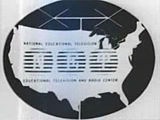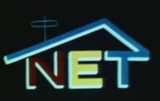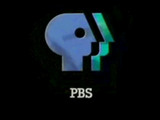- PBS idents
-
PBS idents are television idents used by the US Public Broadcasting Service (PBS). Programs distributed to its member stations end with a television ident including the PBS name and logo and often a voiceover, known in the industry as a "system cue". From October 5, 1970 to September 30, 1984 the logo was usually displayed on-screen for eight seconds. Since October 1, 1984 the logo has appeared on-screen for five seconds.
This article also covers the idents used by PBS's predecessor, National Educational Television.
Contents
NET idents
1st logo
The National Educational Television and Radio Center was established in November 1952. Its original on-air logo was used from then to September 30, 1962. It was a two-dimensional still shot of a white map silhouette of the United States inside a black oval over a white background. Inside the map design are three sets of segmented lines shaped like television monitors with the letters NET inside each box. A TV antenna appears vertically through the map design with the words National Educational Television at the top and Educational Television and Radio Center underneath. A version with a circle saying NET and a version with a map saying National Educational Television have also existed.
2nd logo
The original ident for the National Educational Television was used from October 1, 1962[1] to October 2, 1966. It was a simple still shot of the network's logo—the letters "NET" with a slanted roof coming out of the top-right of the "T", hanging over the "N" and the "E," with a small antenna sticking out over the "N." There are also "stars" all over the screen. Meanwhile, an announcer says, "This is National Educational Television."
3rd logo
The third ident was used from October 3, 1966 to February 18, 1968. First, gray dots appear and disappear rapidly. A white circle is drawn around the dots. A vertical line is drawn over the circle, but then is erased. A small fire appears in the circle. Several curved vertical and horizontal lines cover the circle to create an image of the globe. Several white lines appear under the globe to form the letters "NET". The globe ultimately winds up on top of the "T". The music playing in the background during the animation is industrious-sounding. When the animation is complete, an announcer says, "This is N-E-T, the National Educational Television network."
4th logo
First, the left section of the screen fills with red from the bottom, the middle section fills with yellow from the top, and the right section fills with blue from the bottom. One by one, each colored section flips to form the letters N E T on a black background. The letters move closer together and "NATIONAL EDUCATIONAL TELEVISION" appears, or a blue line is drawn above the letters, which morphs into a gable roof with an aerial antenna on top, which is connected to the T. An announcer says, "This is NET, the National Educational Television network." On later variants, a different announcer says, "This is NET, the public television network."
The music was a synthesizer score composed by Eric Siday (1905-1976), who also composed the score for the similar-sounding Screen Gems and CBS color programming logos.
The color versions of the opening and closing idents are released on the second volume of Sesame Street: Old School with the first test pilot episode.
There is also a B&W version in which the "NATIONAL EDUCATIONAL TELEVISION" text appears instead of the line,from 1968 to 1969.PBS idents
1st logo
The first PBS ident was used from October 5, 1970 to October 3, 1971. The first logo for PBS was a black background with the words sandwiched on top of each other:
Public
Broadcasting
ServiceThen, actor MacDonald Carey (1913-1994) says, "This is PBS, the Public Broadcasting Service."
2nd logo
The second PBS ident was used from October 4, 1971 to September 30, 1984. This ident was used on a less regular basis until 1991, when it was completely taken off PBS. It features cel-animated tricolor letters that assemble onscreen to form the logo, similar to the concepts used for production logos from that era, such as those from MTM Enterprises.
This logo starts with a full-screen abstract blue "P," which zooms out to the upper-middle, taking on the shape of a face in profile as it moves left. Soon after, an orange "B" and then a green "S" appear, with dots punched out to form the letters. In tandem with the letters appearing, the words "PUBLIC BROADCASTING SERVICE" appear individually at the bottom of the screen, left-justified, and in the sans-serif ITC Avant Garde font.
This ident was designed by Ernie Smith and Herb Lubalin of the Lubalin Smith Carnase design studio, on assignment from the Lawrence K. Grossman advertising agency, whose creative chief, Ron Aigen, directed the logo search. The agency then commissioned the accompanying music, composed by Paul Alan Levi, which consists of a bold Moog synthesizer score, beginning with a rapidly descending, telephone-like scale, followed by five warm, heavy brass-like notes. This was the only logo used for PBS programming until the third PBS ident debuted in 1984. The ident is featured on the Sesame Street: Old School and The Best of the Electric Company DVD sets.
3rd logo
The third PBS ident was used from October 1, 1984 to October 1, 1989. The logo was developed by Chermayeff & Geismar.
The ident starts with a blue abstract profile of the human face, facing right, set on a black background. A piece comes out to the right, and settles a short distance from the profile. The letters "PBS" appear below in a white, slab serif typeface. The accompanying music, composed by Jonathan Elias, consists of a majestic piano chord accompanied by some pizzicato tones, then a softer version of the piano chord.
A version of the logo appeared at the end of the first episode of Square One Television in which it appeared as normal, then multiplied with a background chorus singing "And on, and on, and on...". This was to coincide with the song "Infinity", which was featured in that episode.
A 3-D version of this ident is included on the Saturday Night Live Best of Phil Hartman DVD; this PBS ident introduced Hartman's The Anal-Retentive Chef sketches on that show.
4th logo
The fourth PBS ident was used from October 2, 1989 to August 1, 1993. On a black background, a side-facing transparent blue P-head moves to the right, leaving behind a trail of P-Heads. The trailing P-Heads fades into the PBS logo from before, which blends into the center of the screen, occupying almost all of it. Several white and rainbow lines streak across the bottom of the screen, leaving the text "PBS" in the same font as before to the bottom left. All of a sudden, an announcer says, "This is P-B-S."
In an alternate version of the ident, the P-head appears just by fading in with the PBS text. No lines streak across the screen; therefore it is a still version of the ident. The same music, as in the ident's original version, is used. Once again, the announcer says "This is P-B-S."
There is a silent version as well, but this is very rare.
5th logo
The fifth PBS ident was used from August 2, 1993 to September 1, 1996. It starts with a pink glass circle rotating while the faces of various people appear and disappear within it. Then, we zoom out through the eye of the stylized P's in an orange/pink installation art environment. The familiar "PBS" text spins in, in white and to the left of the P. The accompanying music, composed by Peter Fish, is a jazz-style boogie, with a female voice singing in the background. Then, a male voice says "This is P-B-S."
This ID is not animated with computer graphics, but rather was created traditionally on film. The stylized P is frosted glass, and the PBS text is rotated into place by rods beneath a rostrum.
This logo was the last to be used on both adults' and children's programming. Beginning in 1993, children's shows used special idents.
6th logo
The sixth PBS ident was used from September 2, 1996 to November 1, 1998. Its composition now included of a variety of objects: A telescope rotates in the lower left corner; a globe of the Earth appears at upper right; while at center a framed windowpane zooms in. The various objects fade away to reveal the stylized P's, which are initially yellow-green with the right section colored blue. These colors change to blue and green, respectively, while the "PBS" text fades in below. The end result resembles the 3rd ident. Then, actress Lauren Bacall says "This is P-B-S".
7th logo
The seventh PBS ident was used from November 2, 1998 to September 1, 2002. It is a combination of live action and computer effects. It begins with a man or woman holding up a black, round disc printed with a white PBS logo. As he/she holds the disc in front of his/her face, several superimposed acrobats jump and somersault behind the person, in a circular pattern. The letters "PBS" appear in black to the right of the disc, with the PBS website address (www.pbs.org) below the letters. This is the first time the website address has appeared in a PBS ident.
The accompanying music is a world music/new age piece, with Lauren Bacall once again saying "This is P-B-S." Sometimes, Bacall will say "You're watching your public television station, P-B-S." People who have held the round disc in this ident include Jocelyne Loewen, Jake Martin, Kyle Hebert, Lynne Thigpen, Michelle Ruff, Chris Rock, Steve Burns, Gong Li, and even Bacall herself.
This ident also introduced a minor change to the PBS logo. From hereon, the PBS profile logo always appears in a black circle, with the "PBS" text to the right.
8th logo
The eighth PBS ident was used from September 2, 2002 to September 27, 2009. It features live-action footage filmed on a large set with a hardwood floor and shaggy brown curtains and has many variants, including "Young People" (voiceover by Edie Mirman), "Performers" (voiceover by David Kaye), "Flowers" (voiceover by Helen Mirren), "Daddy and Son" (voiceover by Kyle Eastwood), "Cowboy" (voiceover by David Kaye), and "Generations" (voiceover by Edie Mirman). It ends with the PBS logo animating over the scene. Each variant has its own special arrangement of the current PBS promo music, along with a voiceover. The voiceover is one of these four people saying "We are P-B-S," or occasionally, "I am P-B-S."
There is also a version that uses a purple-blue background instead of the original shaggy brown curtains. The words "Perspective. Analysis. Understanding." flash briefly and fade out, then "Be More" scans to the right, followed by "PBS" in white. Bob Hilton says, "This is P-B-S." This variant can only be seen on Frontline.
9th logo
The ninth PBS ident was used from September 28, 2009 to present.[2] The idents show parious people engaged in different, leisurely activities, some stargazing and others reading a scrapbook. Each ends with a voiceover saying "Be more P-B-S," or occasionally, "You"re watching P-B-S." The "Be more" slogan is displayed, with the PBS logo to the right. "PBS" in text follows, which transitions to the website "pbs.org."
PBS Kids idents
1st ident
Prior to 1993, PBS Kids television programs used the same PBS idents seen on adult-oriented programming (or the logos of National Instructional Television). Starting on October 11, 1993, a new ident was commissioned specifically for children's programming.
It consists of three stylized P profiles, depicted as literally living things, complete with appendages, drawn as a cartoon, set on a white background. The profiles are in different colors and patterns that change throughout the ident and eventually stop on blue, orange, and green, respectively. The profiles dance and sing "This is P-B-S! Woo-hoo-hoo!,", then stop when the 1993 Ready To Learn dog walks by the lower portion of the screen and barks. (he holds a balloon saying E/I in the re-designed one) At the same time, the third profile ad libs and his red hat flies off of his head for a moment, then drops back on his head. The "PBS" text appears in black to the lower left to the profiles. The music is a pop-rock tune with the profiles singing at once.
2nd ident
Six new idents for PBS Kids began airing on September 6, 1999, replacing but still using the "P-Pals" ident. Each featured PBS Kids' boy and girl mascots, Dash and Dot. On all versions, the PBS Kids logo appears at the end on a background of some kind of a pattern. On the first variant, Dot runs up to the screen and a thought bubbles appears with the letters "PBS" in it. The second variant is of Dash scratching his head and thinking of "PBS." The third variant has Dot transitioning forms: a cat, an octopus, and an astronaut The fourth is similar to the one prior to it. It has Dash in three forms: a caveman, a scuba diver, and a robot. The fifth variant has Dash ice-skating in a snow globe which is held by Dot. The final version has Dash looking in his fish bowl to find Dot as a fish and swallows himself as a fish. These idents are no longer shown on new programs, but are continually seen on older versions of programs.
3rd ident
Several new idents were produced in 2008. Themes for the idents (featuring Dash and Dot) include: telescopes, rock climbing, picnics, gardens, and magnets among many others. These idents are in high-definition.
PBS Kids GO! idents
Prior to October 11, 2004, all PBS Kids programs used the started series idents. Starting in the fall of that year, another series of new idents were commissioned for use on programming with a focus on telling children to be active. They consist of kids doing several forms of exercise on a set with a block motif. At the end, one of the kids pushes a lever, or pushes a button (or activates some kind of mechanism), which reveals PBS Kids GO! logo: a speech bubble with the words "PBS Kids GO!" in it. The accomanying music is a flute and glockenspiel tune, ending with kids shouting "GO!" Most of the idents have a whistling tune as well. As with other current PBS idents, there are several variations, like one with kids riding on a bicycle, one with kids making the logo appear on the computer, or one with kids building the logo with blocks. There have been several sets of these idents.
PBS Kids Sprout idents
PBS Kids Sprout got its first ident in 9/26/2005, which consists of a green flower with the words "PBS Kids" written on it and the word "sprout" under it in children's handwriting.
PBS Kids Preschool Block
Within the PBS Kids Preschool Block, there are many different idents after each program. They do not include the PBS Kids boy or girl as of September 1999, except for the last few seconds when Dash is shown in the PBS Kids logo. Some include still pictures of real children, but they do occasionally move a little bit. These idents usually have a general theme, such as dinosaurs, bees, a picnic, or someone taking pictures with a camera. In later seasons, they were replaced by what Dash and Dot are doing before his/her ident appears.
PBS Home Video idents (1989-present)
At first, PBS distributed copies of its programs on its own, under the "PBS Video" label. There was no special ident for PBS Video. The tapes were simply copies of PBS' master tapes. Then PBS introduced its "PBS Home Video" label, going through commercial distributors: Pacific Arts (October 1, 1989–August 31, 1994), Turner Home Entertainment (September 1, 1994–August 31, 1997), Warner Home Video (September 1, 1997–September 1, 2004), and currently Paramount (September 2, 2004-Present). PBS Home Video idents are usually modeled after past TV idents.
1989-1998
The first PBS Home Video ident was used from 10/2/1989 to 11/1/1998. The large 3-D glass profile is set on a black background, filling the screen as it did on the TV ident. Initially, a cloudy sky pattern fills the profile, which then fades to a blue stylized P against the cloudy sky background. Lines shoot into the profile's eye, and "PBS HOME VIDEO" appears below in the familiar slab serif typeface. The text is filled with a "water" pattern. The accompanying music is a classical tune, along with an announcer saying: "The following presentation is from PBS Home Video." On some tapes, a PBS television ident appears afterward. The ident would sometimes lack the announcer.
1998-2004
The second PBS Home Video ident was used from 11/2/1998 to 9/1/2004. This ident varies in color. three circles of a certain color touch. Then it zooms out resulting the P head and the words PBS DVD. The Ident's color could be either blue, green, red, and purple
2004-2009
The third PBS Home Video ident was used from 9/2/2004 to 9/27/2009. It begins on an ethereal blue/purple/red CGI background, then the PBS logo appears within a circle with "Be more" on the left, "PBS" to the right. Sometimes, only "PBS" appears.
2009-present
The fourth PBS Home Video ident has been used since 9/28/2009. It is based on the blue version of the generic 2009 PBS ident.
References
- ^ George W. Woolery, Children's Television: The First Thirty-Five Years, 1946-1981 Part II, p. 594. The Scarecrow Press, 1985. ISBN 978-0-8108-1651-0
- ^ http://www.pbs.org/aboutpbs/news/20090925_pbsmultiplatform.html
Seen on youtube. Keywords All the PBS logos
External links
Categories:- Film and television logo descriptions
- Public Broadcasting Service
Wikimedia Foundation. 2010.












